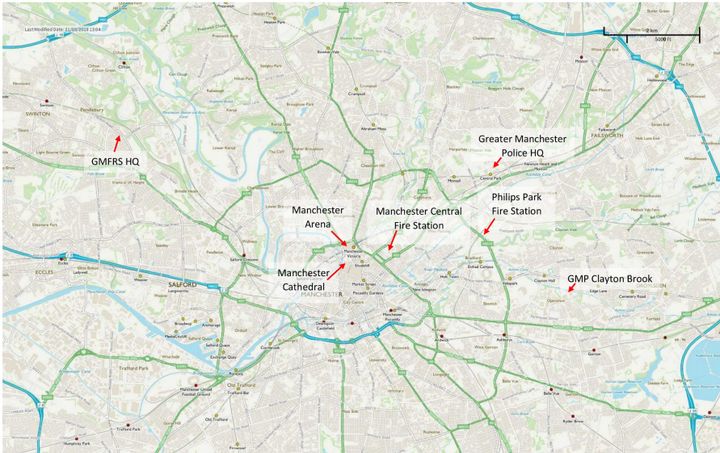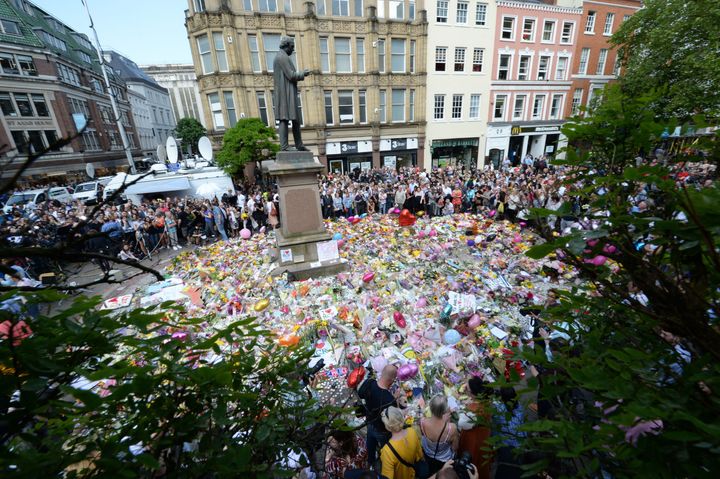The Manchester fire service played “no meaningful role” for two hours after a suicide bomber killed 22 people at an Ariana Grande concert last year, an independent investigation into the emergency response has found.
The Kerslake Review, commissioned in the wake of the bomb attack at the Manchester Arena on 22 May, also heavily criticised the media, with many victims’ families describing being hounded by journalists.
One person quoted said: “They … are a disgrace, they don’t take no for an answer, they have a lack of standards and ethics.”
However the report also noted the “enormous bravery and compassion” of both the public and the police and ambulance services, as well as the “enormous strength of the civic leadership and partnership in Greater Manchester”.
The report is now calling for a review of how emergency services communicate and respond to terror attacks, and advises the Independent Press Standards Organisation (IPSO) to examine how the media interacts with victims.
The Fire Service Response - What Went Wrong
The report lays out in detail a series of communication failures that led to fire services setting up a rendezvous point over three miles away from the scene of the attack, meaning they were “out of the loop” during the emergency response.

- At 22:35 the North West Fire Control operator (NWFC) was informed of ‘an explosion and that a bomb has exploded’ prompting him to initiate the relevant action plan
- As part of this the National Inter-Agency Liaison Officer (NIALO) was informed at 22:40 and was made aware of the explosion
- Based on the information given, the NIALO couldn’t rule out the possibility of a Marauding Terrorist Firearms Attack (MTFA) - like that which occurred in Paris in 2015
- MTFA protocol states that first responders shouldn’t be sent into potential danger without sufficient protection. As a result the Philips Park Fire Station, 3.2 miles away from the Arena, was chosen as the fire service rendezvous point
- By 23:53 four fire engines, two Special Response Teams and three NIALOs were at Philips Park Fire Station, 3.2 miles away from the Arena
- At 00:12 there were still no fire services at the scene of the explosion so the CFO sent three fire engines and an NIALO
- The elapsed time between NWFCO creating the initial incident log and the arrival of these assets at the scene was 1 hour 59 minutes
Consequences Of The Fire Service Response
The special response teams were equipped with Sked stretchers, specifically designed for the rapid evacuation of casualties from disaster zones.
However as these were not available until so late in the response, stretchers had to be improvised using whatever was available. The report notes:
At this time, there were no stretchers available, so the responders rapidly improvised by using display boards and metal crowd barriers to carry the injured. Individuals who witnessed this stated how amazed they were to see how this portage was carried out through rapidly developing teamwork
There is no indication in the report that the response of the fire service led to further loss of life.
The Media - What Went Wrong
The report notes a number of disturbing incidents.
- In the case of one family, the daughter was visited by a reporter at their home and given condolences on the death of her brother whilst her parents were at the Etihad Stadium. This took place on the morning following the attack. The family were not told that their son was likely to be among the fatalities until later that day.
- One mother, who was herself seriously injured as was her daughter, spoke of the press ringing her on her mobile whilst she was recovering in hospital.
- A member of staff on her ward spoke of a note offering £2,000 for information being included in a tin of biscuits given to the staff.
- The child of one family was given condolences on the doorstep before official notification of the death of her mother.
- Another family told how their child was stopped by journalists whilst making their way to school.
- There were at least two examples of impersonation. One respondent talked on the phone to someone saying they were a Bereavement Nurse; whilst another described talking to someone who they felt sounded to be more like a journalist but who purported to be from the police.
The Media - What Went Right
More positively, a number of families spoke in praise of sympathetic reporting by the Manchester Evening News and other papers local to the bereaved.

The Civic Response
The response of Manchester’s citizens as well as its leaders are widely praised in the report and contains a number of quotes from those affected by the attack.
““The people of Manchester did a fantastic job of boosting the morale of thoseaffected, making us feel as though we were not alone.””
“In a nutshell, what services have done for us, after that horrific time was fantasticand we couldn’t have asked for more.””
“The Chief of Police, Ian Hopkins, stayed for one and a half hours and AndyBurnham also stayed over an hour. These visits felt significant, practical andhelpful.””
The report notes:
The Panel feels very strongly that this cannot be as good as it gets. We recommend that the Independent Press Standards Organisation should review the operation of its Code in light of these experiences and that there is exploration of ways to enhance the skills in media handling for the Family Liaison Officers.
One other decision highlighted was that made by the the Force Duty Officer at the Arena.
At this point, the Force Duty Officer had to decide whether to implement a withdrawal of all responders from the foyer, as is laid down within Marauding Terrorist Firearms Attack protocols. The Force Duty Officer decided that to tell these responders to evacuate would have been unconscionable. Accordingly, but in clear consideration of the Joint Operating Procedures, the Force Duty Officer used professional discretion and left the responders in place.
Speaking at a press conference on Tuesday afternoon, Lord Kerslake was asked why the report praised this officer when if he had been wrong, there could have been many more deaths.
Kerslake said: “We felt that judgment was crucially important and the right one in the circumstances.
“You need procedures in place that people can follow and understand but you also need to reach judgements based on your best knowledge on the ground and that’s what the Force Duty Officer did.
“He made that judgement knowing that if he’d got it wrong we’d have been having a different press conference today so in our view it was a courageous and correct judgement at the time.”
